Groton, CT –In the largest award for Long Island Sound research in the history of the collaboration between the Connecticut and New York Sea Grant programs and the EPA’s Long Island Sound Study, 13 projects have been selected that will improve understanding of factors impacting several fish species, shellfish, water quality and restoration of the estuary’s salt marshes.
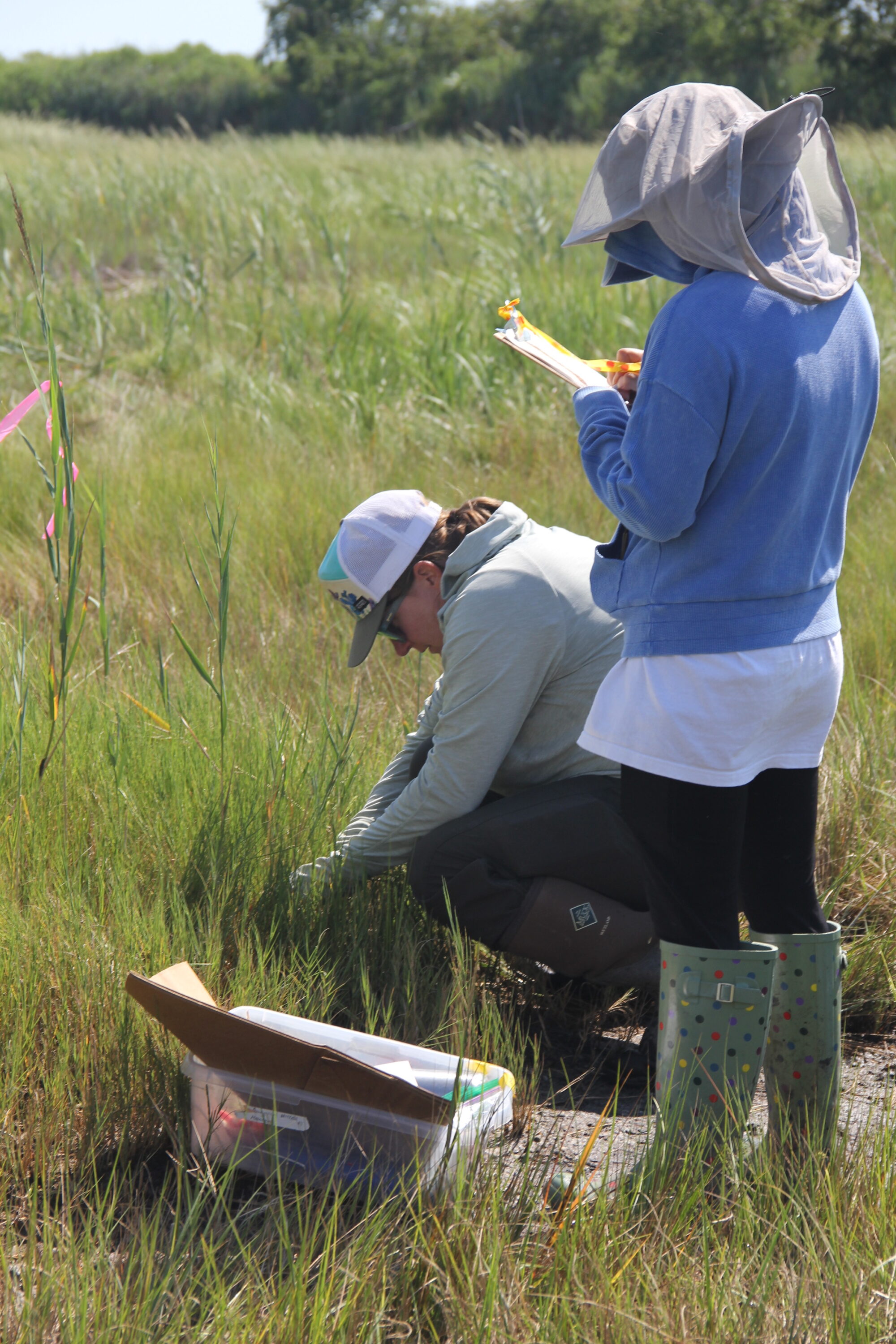
“New York Sea Grant is thrilled to continue this long-standing partnership with the EPA Long Island Sound Study and our sister program across the Sound, Connecticut Sea Grant,“ said Rebecca Shuford, director of New York Sea Grant. “The most recent award cycle represents the largest single investment in the LISS research portfolio to date. With topics ranging from water quality improvement to salt marsh restoration to fish and shellfish population dynamics, all with explicitly defined societal benefit and actionable outcomes, we are certain this body of work will make a tangible impact on the interlinked ecosystems, communities, and economies of the Long Island Sound.”
The awards will provide scientists at five institutions in Connecticut and New York with $6.7 million in research funding, leveraging an additional $3.5 million in matched dollars. The one- to two-year projects will begin in January. The research initiative is designed to support science-based management of the Sound and its resources, and the implementation of the Long Island Sound Study’s Comprehensive Conservation and Management Plan for the waterway.
“The diversity of projects reflects the need to care about not only water quality, but also habitats and associated fish and shellfish, to gain information on Long Island Sound as a whole ecosystem,” said Sylvain De Guise, director of Connecticut Sea Grant. “What those projects have in common, though, is that they all aim to inform management practices to continue to improve the health of Long Island Sound as an important resource for economic and recreational activities.”
The Long Island Sound Study distributed the federal funds to Connecticut Sea Grant and New York Sea Grant to manage the research project program. The Long Island Sound Study began the research funding initiative for the Sound in 2000, and the Sea Grant programs took over management of it in 2008.
The Long Island Sound Study, developed under the EPA’s National Estuary Program, is a cooperative effort between the EPA and the states of Connecticut and New York to protect and restore the Sound and its ecosystem. To learn more about the Long Island Sound Study, visit the website.
“This research award is an investment that demonstrates EPA’s dedication to developing evidence-based solutions to enhance water quality, restore critical habitats, and build resilience against climate change impacts,” said Lisa F. Garcia, administrator for EPA Region 2, which includes New Jersey, New York, Puerto Rico, the U.S. Virgin Islands and eight Indian Nations.
“By deepening our scientific understanding of the Sound’s ecosystem, we’re helping communities better protect this treasured resource for future generations.”
EPA New England Regional Administrator David W. Cash said the funding will pay dividends far into the future.
“This funding will enable the collection and analysis of vital scientific data to inform our management decisions and help ensure a healthier, more resilient Long Island Sound for years to come,” he said.
One group of projects will explore water quality issues, including hypoxia and excess nutrients entering the estuary:
- “Reducing Non-Point Source Nitrogen Loads from Residential Septic Systems: Identifying Barriers and Opportunities for Large-Scale Water Quality Improvements.” PI: Jamie Vaudrey, CT NERR, University of Connecticut; federal funds: $812,255
Summary: Households will be surveyed about alternatives to septic systems, and the results will be used to inform management actions that may include incentives and programs to reduce economic barriers to new systems. The project will also address nitrogen loads from coastal communities and fertilizer use under current and future scenarios and assess costs and impacts of a program to promote alternative treatment systems. Outreach materials will be used to communicate ways to engage residents in efforts to reduce nitrogen inputs. - “Improved Mechanistic Understanding of Hypoxia Drivers in Western Long Island Sound Enabled with Data from a Wire-Following Profiler and Coupled Biogeochemical-Hydrodynamic Modeling.” PI: Cara C.M. Manning, University of Connecticut; federal funds: $499,570
Summary: Oxygen depletion, wave action, gas exchange and other variables will be measured in the western Sound using an electronic profiler and modeling over a four-month period. The data will be used to improve understanding of the factors that lead to hypoxia, and the duration and severity of hypoxic conditions. - “Testing Dissolved Oxygen Models in Long Island Sound.” PI: James O’Donnell, University of Connecticut; federal funds: $750,000
Summary: Three hypothesis about the mechanisms controlling hypoxia in western Long Island Sound will be tested. The testing will be done with new but demonstrated equipment to create a dataset describing oxygen exchanges and mixing. An advisory committee will guide the project and ensure that its outputs are useful to people involved in management of the Sound. - “Nutrients, Algal Blooms and Hypoxia: Retrospective and Prescient Approaches for the Future Management of Long Island Sound.” PI: Christopher J. Gobler, Stony Brook University; federal funds: $325,658
Summary: This project will assess effects of excess nutrients on the proliferation of phytoplankton and harmful algal blooms (HABs), hypoxia and carbon sinking under different temperature scenarios expected with climate change. It will also identify levels of nutrient reduction needed to reduce these effects, solicit feedback and communicate findings with CT and NY management agencies. - “Assessing the Role of Nitrogen Form and Inputs on Long Island Sound Harmful Algal Bloom Development for Actionable Water Quality Management.” PI: Dianne I. Greenfield, City University of New York; federal funds: $597,845
Summary: Researchers will evaluate water quality, nutrients and phytoplankton at sites directly downstream and away from wastewater treatment plant outfalls during dry and wet periods, assess the relationship between nitrogen inputs and HABs, and identify tipping points that trigger HABs species proliferation. Findings will be shared with shellfish managers, municipal wastewater agencies, advocacy groups and researchers.
Another group will study various aspects of salt marshes dynamics and restoration challenges:
- “Tidal Marsh Mediation of Long Island Sound Embayment Nutrient Dynamics.” PI: Craig Tobias, CT NERR, University of Connecticut; federal funds: $498,074
Summary: Researchers will quantify the impact of salt marshes on nitrogen levels in Long Island Sound embayments, an important factor in water quality and overall ecosystem health. Isotope tracers and other techniques will be used to model how nitrogen is buried in marshes and then reintroduced to embayment waters via drainage of marsh waters. - “Quantifying Patterns and Drivers of Marsh Elevation Change Across Long Island Sound: Using an Existing Data Network to Inform Restoration Planning and Implementation.” PI: Giovanna McClenachan, Stony Brook University; federal funds: $332,282
Summary: At specific salt marshes in CT and NY, rates of elevation gain will be calculated, landscape conditions influencing elevation change will be quantified, and plant decay rates measured. Restoration managers will be provided with data to maximize tidal marsh elevation gain, increasing their resilience to sea level rise. - “Advancing Coastal Wetland Restoration Outcomes: Examining Temporal Trajectories and Spatial Variation of Past Management Interventions Across the Long Island Sound.” PI: Beth A. Lawrence, University of Connecticut; federal funds: $838,517
Summary: Researchers will evaluate salt marsh restoration recovery progress and resilience over time, using field date from restoration sites across the Sound. The results will be used to inform diverse audiences about the challenges and opportunities of coastal restoration. - “Impact of Adaptive Management and Assisted Migration on Salt Marsh Restoration Health and Resilience.” PI: Sarah C. Crosby, The Maritime Aquarium at Norwalk; federal funds: $431,535
Summary: Characteristics of soils and grasses planted at successful and unsuccessful restoration sites in Great Meadows Marsh in Stratford will be assessed to provide guidance to improve restoration outcomes. Salt marsh grass species from local and southern sources will be planted within and outside of structures that mimic warming climate conditions to inform future restoration work. - “Deciding When, Where and How to Use and Amend Sediment Additions to Increase Salt Marsh Resilience.” PI: Ashley Helton, University of Connecticut; federal funds: $550,000
Summary: The practice of using soils from dredging projects to raise salt marsh elevation and enhance marsh resilience will be assessed to determine when and where these soils become acidic and inhibit plant growth, decreasing value for wildlife and reducing carbon storage. Researchers will quantify the effects of flooding and amendments to dredged soils to act as a buffer.
Two of the projects will look at important fish species facing declines: river herring and four types of flounder, and a third will study the effects of farmed oysters on wild populations. These are:
- “Bottoming Out? Testing Hypothesis on Why Long Island Sound Flatfishes Are Disappearing.” PI: Eric T. Schultz, UConn; federal funds: $283,128
Summary: Research will seek to determine the role of increasing competition for food in declines in four flatfish species (summer flounder, windowpane flounder, winter flounder and fourspot flounder). Stomach contents of these flatfish species along with those of recently abundant competitor species (black sea bass, scup and dusky smoothhound) will be analyzed. - “Forecasting How Future Droughts and Land Development Will Impact River Herring Populations with Hydrologic- and Population-Dynamic Modeling.” PI: James O. Knighton, University of Connecticut; federal funds: $496,219
Summary: Researchers will create a dataset of the age and size of in-migrating adult river herring and out-migrating juveniles over two seasons and compare with historical samples to determine the impacts of streamflow and diminished connectivity among spawning ponds on population health. Forecasts of how future climate and land cover change will impact river hearing populations will be developed to inform management decisions. - “Restorative Aquaculture: Measuring the Extent of Ecosystem Services from Aquaculture Farms.” PI: Matthew P. Hare, Cornell University; federal funds: $242,754
Summary: Research will investigate the contribution of oyster farms to wild oyster populations through migration of larvae from farmed oysters into native populations. Positive and negative consequences of genetic mixing of wild and farmed oyster populations will also be assessed.
“The number of selected research projects is the largest ever for the Long Island Sound Study-NY Sea Grant-Connecticut Sea Grant collaboration,” said Syma Ebbin, research coordinator at Connecticut Sea Grant. “It reflects growing federal investment in and recognition of the benefits of generating better scientific understandings coupled with end-user focused applications aimed at improving the quality and management of Long Island Sound.”
Lane Smith, research coordinator for New York Sea Grant, said this research investment will improve management of Long Island Sound.
“We are excited to make these researchers’ projects a reality, and look forward to their results,” Smith said. “This research will benefit the Sound community and bring us new information on how best to manage and care for the Sound ecosystem.”
More information: Judy Benson, Connecticut Sea Grant: judy.benson@uconn.edu, Paul Focazio, New York Sea Grant: paul.focazio@stonybrook.edu
About New York and Connecticut Sea Grant:
New York Sea Grant, a cooperative program of Cornell University and the State University of New York (SUNY), and Connecticut Sea Grant, based at the UConn Avery Point campus in Groton, are two of 34 university-based programs under the National Oceanic and Atmospheric Administration’s National Sea Grant College Program.
This news release was originally distributed by CT Sea Grant on Dec. 11, 2024.
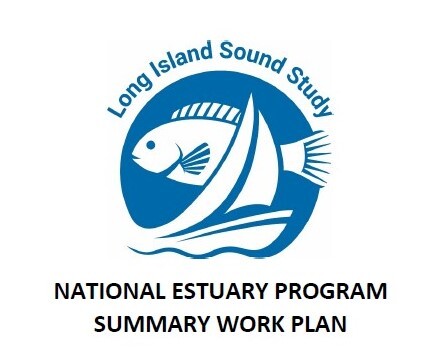
Each year the Long Island Sound Study develops a Work Plan as part of the National Estuary Program. The work plan describes the work conducted with EPA funds to help achieve the goals of the Study’s Comprehensive Conservation and Management Plan. The 2024 Work Plan covers LISS activities planned with 2024 federal funds for Oct. 1, 2023 to Sept. 30, 2024 (fy25). It also highlights projects undertaken from Oct. 1, 2023 to Sept. 30, 2024 (fy24) with 2023 federal funds.
- LISS 2024 National Estuary Program Work Plan
- Appendix 1: Base Projects Funding
- Appendix 2: BIL Projects Funding
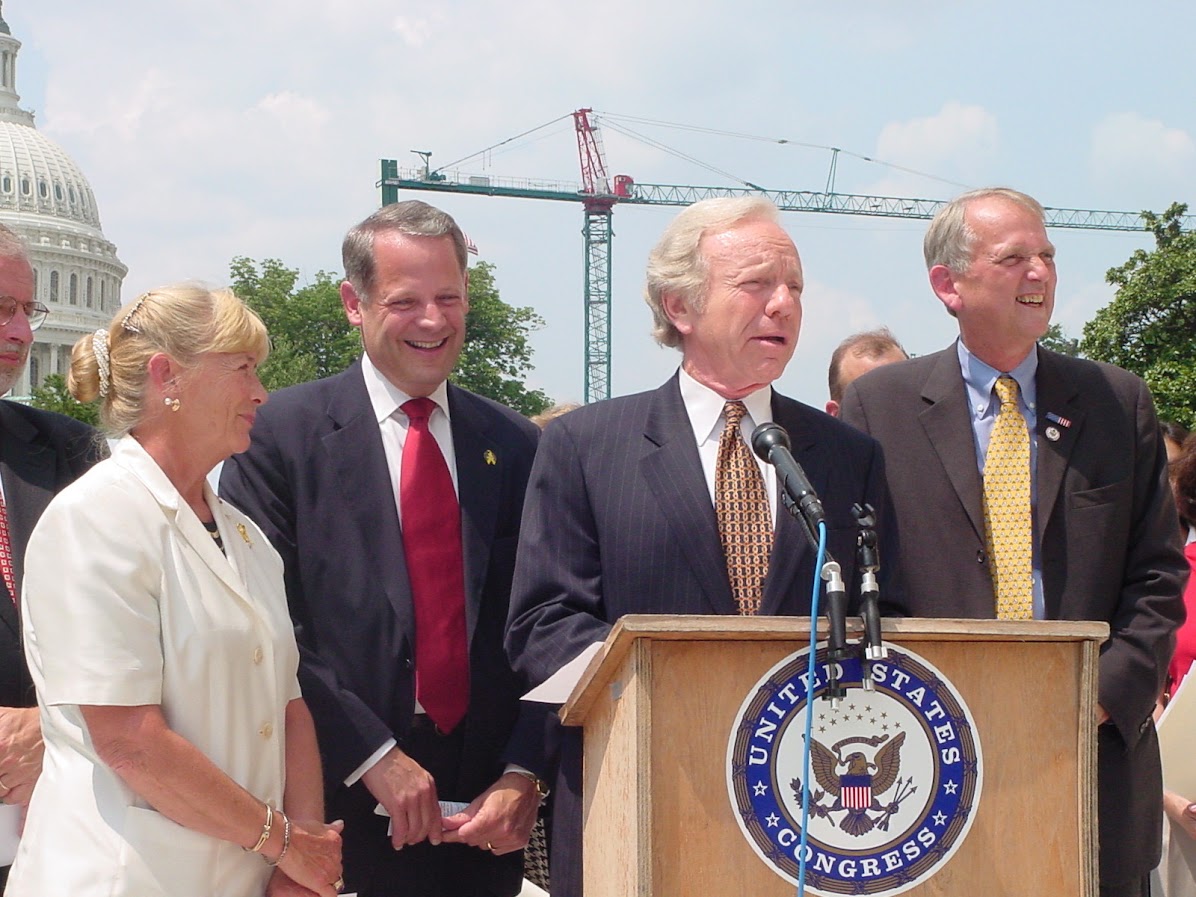
Former U.S. Senator Joe Lieberman of Connecticut, who died from complications of a fall in March, championed many environmental causes in the Senate. Among his successes was creating legislation that played a critical role in establishing long-term efforts to restore and protect Long Island Sound.
As a freshman Senator in 1989, Lieberman joined the Senate’s Committee on Environment and Public Works where he helped draft the Long Island Sound Improvement Act. In a 2013 interview with the Grist, an online magazine, the senator explained why he sought the committee post.
“I’m proud that one of my first acts as a senator, even before I was sworn in, was to request a seat on the Environment and Public Works Committee in the Senate because I knew it was from there that I could do the most good to protect and improve our environment.”
At the time, Long Island Sound was faced with a many water quality issues, including depleted oxygen levels leading to massive fish kills, medical waste and other debris washing up on beaches, and a legacy of toxic contaminated sediment from the Sound’s industrial past. The Act, which became law in 1990, created an Environmental Protection Agency program office for Long Island Sound with a full-time director, an annual budget, and a charge for EPA to develop and implement a Comprehensive Conservation and Management Plan with support from a Management Conference. It made permanent the Long Island Sound Study, a federally-funded study established in 1985 to address issues of poor water quality, which was set to expire in 1991. Today, that office, located at the Stamford Government Center, manages a $62.7 million budget, coordinating over 500 projects throughout the Sound’s 16,000 square mile watershed.
Lieberman laid out the importance of local coordination through the the Long Island Sound Study and the office in 1989 at a public hearing he co-chair in Bridgeport to collect testimony on the bill. At the hearing, the senator discussed the need for an EPA field office to streamline restoration efforts, which were at the time being managed by two regional EPA offices (New York and New England), two states, and over 150 local governments. The Long Island Sound Study and its partners recognized the importance of working with local government and community involvement since many of the Sound’s challenges, including nitrogen pollution stemming from wastewater treatment plants, fertilizer usage, and atmospheric deposits, originated from the land. The legislation was modeled after similar efforts for Chesapeake Bay.
“If we’re really going to do what we want to do and that is to clean up the Sound there needs to be coordination of all that activity and management and that’s what this office will be all about,” he said at the hearing. “It will become the focal point of our efforts to preserve this tremendous natural resource Long Island Sound for ourselves and for our children.”
The Stamford native and Yale University Law School graduate started his career in public office in the state Senate from 1970 to 1980. He was the state Attorney General from 1982 to 1988, a position where he took pride in enforcing environmental law.
“I hauled polluters into court and made them pay,” he said in the Grist interview. “In fact, a corporate defense firm had to dedicate a whole wing of its office to defend those suits. He named it the Lieberman wing. I’m proud of that.”
Besides passing the Long Island Sound Improvement Act, Lieberman’s environmental achievements, included helping to win passage of landmark Clean Air Act Amendments in 1990. He also wrote legislation to hold oil and shipping companies liable for the damage they caused; and helped co-author the Pollution Prosecution Act of 1990 which quadrupled the number of EPA investigators. For Connecticut, he worked to create the state’s first national park at Weir Farm in Wilton.
In the 2000s, he was active in supporting bipartisan efforts to combat climate change and worked with the environmental community to protect the Arctic National Wildlife Refuge. In 2006, he sponsored another piece of Long Island Sound legislation, the Long Island Sound Stewardship Act. The act formally established the Long Island Sound Stewardship Initiative, which identified 33 coastal areas of major recreational and ecological value to develop strategies to protect and enhance them. Rather than focusing on the Sound, the Stewardship Act focused on lands such as coastal wetlands that help filter pollution and provide breeding grounds for fish and wildlife. The Stewardship Act followed through on recommendations from the 1994 CCMP, and also addressed the early understanding that solving the Sound’s water quality issues needed to be solved through efforts on land and in the water.
“If there’s one thing I’ve learned through my work this year on the Environment and Public Works Committee,” said Lieberman in his written statement for the hearing in Bridgeport in 1989. “It’s to remember (the conservationist) John Muir. “He said, ‘When we try to pick out anything by itself, we find it hitched to everything else in the universe’.”
Scientists combine a household lawn survey with a nitrogen transport model and water quality data to better inform resource managers where to focus on campaigns to reduce nitrogen from lawn fertilizer
More than one million families live in single-family homes around Long Island Sound. Each of them makes decisions regarding their yards that influence the health of local rivers, streams, bays, and eventually the Sound.
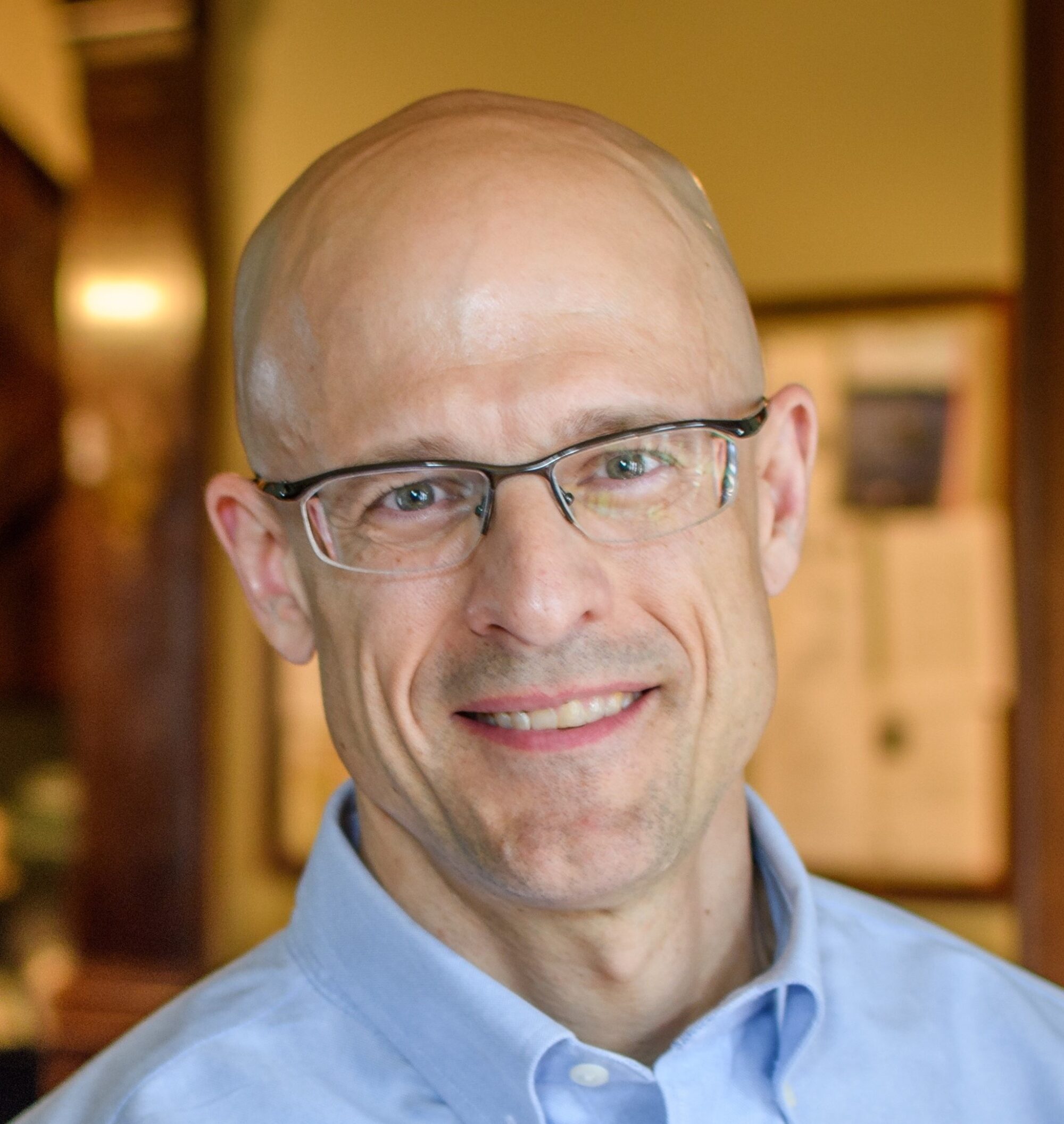
People decide how much fertilizer to apply on their lawns and gardens or none at all. If they apply too much or apply at the wrong time the fertilizer they use will not be absorbed by all of the grass and plants. Instead, the excess nitrogen in fertilizer could end up in waterways—either carried away by stormwater into storm drains and streams or, more likely, transported underground through porous soils toward streams and other waterways that flow to the Sound. Instead of nitrogen fertilizer promoting a green lawn, it could feed the growth of microalgal blooms and thick mats of macroalgae seaweeds along the coast, and result in dangerously low oxygen conditions and harmful algal blooms for the Sound and coastal and fresh waters alike.
Typically, government and environmental groups provide communications materials such as brochures, posters, and web pages to tell homeowners about the need to control the amount of fertilizer to use, in order to protect the environment. But according to Dr. Robert Johnston, an environmental economist at Clark University in Worcester, MA, these types of general information campaigns may not be designed or targeted in ways that most effectively promote positive environmental practices and, ultimately, reduced nitrogen loads to Long Island Sound.
For the past six years, through two research projects funded by the Long Island Sound Study Research Grant Program, Johnston has worked with multidisciplinary teams of marine, environmental, and land use scientists to look for a better way. The latest project, which is to be completed this year, includes the creation of maps that will allow resource managers and policy makers to identify nitrogen “hot spots”— neighborhoods and communities where homeowners are both likely to apply large amounts of fertilizer and where there also is a high likelihood of nitrogen flowing directly to the Sound. “These are the areas where behavior change campaigns can have the greatest impact,” said Johnston. “Because there are large amounts of lawn fertilizer being applied and a large proportion of the nitrogen from that fertilizer is eventually reaching the Sound.”
To support this targeting guidance, he and the research team have created a supplementary model—based on household survey data—that predicts the likelihood that alternative types of policies and programs to reduce fertilizer use will be supported by watershed residents.
“What’s exciting about this project is that it provides outputs that have direct implications for actions,” said Johnston. “What we’re hoping to provide is clear guidance to identify how behavior change programs can be designed and targeted, given that you have limited budgets, to most effectively address nitrogen pollution in particular embayments.”
The issue is important for clean water in the Sound’s embayments—the bays, harbors, and coves that shape the Sound’s coastlines and where millions of people live in coastal communities. Fertilizer use accounts for about one-third of the nitrogen that ends up in embayments. The largest source of nitrogen—about 50 percent—is from human waste, including from discharges of treated sewage in wastewater treatment plants and individual septic tanks from homes. But some embayments receive much higher loads of nitrogen from fertilizer. “In some embayments it’s significantly more than one-third, it’s almost 100 percent fertilizer,” said Dr. Jamie Vaudrey, a marine scientist at the University of Connecticut and the developer of a Nitrogen Load Model for Long Island Sound. “Especially if a community is on sewer and that sewer outfall is somewhere else (discharging waste outside the embayment), then really the big player in those towns is fertilizer applied to households, but also to parks and recreational fields.”
Compounding the problem is a lack of effective policies and programs to address fertilizer use. This is not the case for controlling other sources of nitrogen entering the Sound. For example, billions of dollars have been invested to remove nitrogen into the Sound from human waste through wastewater treatment plant upgrades. Also, Suffolk and Nassau Counties have recently begun a program with support from the New York State Department of Environmental Conservation and the Long Island Sound Study to provide grants to encourage people to replace hundreds of thousands of antiquated septic tanks and cesspools with new systems that have advanced nitrogen reduction technologies.
“For most of these sources, we’re moving in a positive direction, and we have policy levers to control those sources of nitrogen,” said Johnston. “They might be expensive, but we can do it. But residential lawn care is one of the sources of nitrogen that we haven’t reduced very well.”
Researching the Land Use-Water Quality Connection
Johnston has been interested in the connection between the choices people make on land and how it affects water quality since he was a graduate student at the University of Rhode Island in the 1990s. It continued into his job in the 2000s as associate director of Connecticut Sea Grant, which is a member of the Long Island Sound Study’s Management Committee, when the primary focus on water quality in the Sound was the implementation of a federal and bi-state plan to reduce nitrogen loads through the upgrades of wastewater treatment plants. At the time, Sea Grant was funding extensive research on the impact of nutrients on aquatic life in the Sound, which it is still doing today. For Johnston, the opportunity to focus on lawn care arose in 2015 when he coordinated with environmental scientists to use his expertise in developing surveys for a study on residential lawn care practices in the Baltimore metropolitan area that impact Chesapeake Bay. When one of the lead scientists, Dr. Peter Groffman, relocated to New York City to join the City University of New York faculty, Johnston and Groffman decided it was a natural next step to focus on Long Island Sound. In 2018, the two scientists (one social and one environmental) along with Dr. Colin Polsky, an environmental scientist from Florida Atlantic University, received a $371,000 research grant from the Long Island Sound Study Research Grant Program to develop a survey for a model that predicts lawn care practices around Long Island Sound and what policy initiatives households might favor to reduce fertilizer use and improve water quality. They also collaborated on this study with Dr. David Newburn, an environmental economist from the University of Maryland, whose work also emphasizes household landscape decisions and impacts on water quality.
Using random sampling methods, Johnston invited 30,000 households by mail throughout coastal counties of Long Island Sound to answer a web-based survey. A total of 2,344 people responded and answered questions about their lawn fertilizer applications and other lawn management activities, household demographics, housing and yard characteristics, and whether they would support alternative types of policies to reduce the negative impacts of fertilizer use. Their responses were then used to produce predictions of various types of behavior for each household—for example how frequently a household will apply lawn fertilizer and how that fertilizer use would change in response to alternative types of behavior change campaigns.
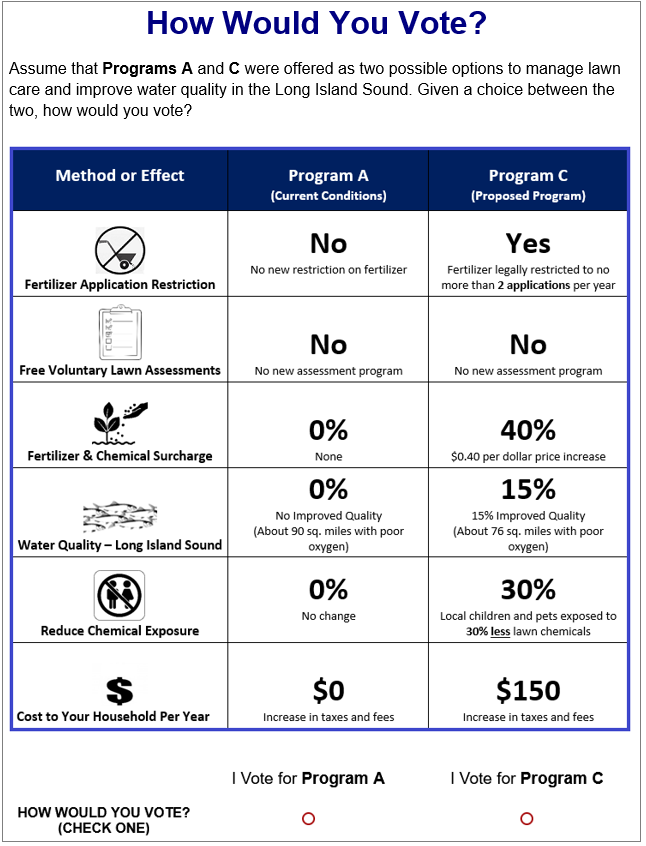
With publicly available U.S. Census and geospatial data on parcel and household characteristics, the researchers are able to produce these predictions for any residential neighborhood or community within the Long Island Sound watershed—for example within the four Connecticut coastal counties or municipalities on Long Island that border the Sound. The researchers use high resolution land cover maps derived from aerial photos to distinguish the lawn area for each household. These predictions can be overlaid with maps showing how much fertilizer applied to each lawn contributes to nitrogen loading in Long Island Sound.
What the Data Reveals
The survey data, said Johnston, reveals “major differences in how people apply fertilizer, how much of that fertilizer reaches the Sound, and how different households react to behavior change campaigns.” It also shows that one of the most significant lawn care decisions people make runs counterintuitive to the notion Americans are obsessed with a perfect green lawn. Almost half of survey respondents—46 percent—said they do not fertilize their lawns. It was a response that did not surprise Johnston. “This is very close to what we found in our prior work in Baltimore and is similar to other studies,” he said. “Most places you look, give or take, roughly 50 percent of the people fertilize their lawn and roughly 50 percent don’t.”
Johnston said that other studies also show that people who choose to fertilize are often influenced by neighborhood norms. “If all else is equal, if your neighbor fertilizes, you are more likely to fertilize,” he said.
For the people who apply fertilizer in the Long Island Sound survey, the most common frequency is between one and three applications a year, although some households apply more frequently. New York residents apply more than Connecticut residents, an average of 1.53 times a year compared to 1.26 times. Generally, households in urban areas with smaller older homes in the region are less likely to fertilize their lawn and have a lower number of fertilizer applications than those in exurban areas. Households in suburban and exurban municipalities closer to New York City in Connecticut or Long Island, especially those with newer larger homes and larger lots, have the highest probability of lawn fertilization and the highest number of fertilizer applications.
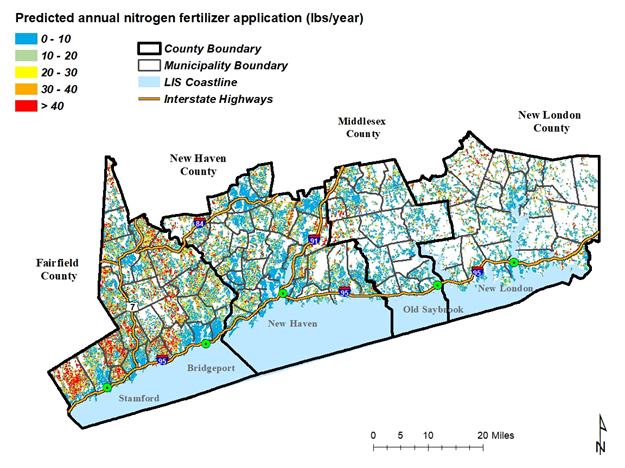
“On average, we find that homeowners with larger and newer homes tend to fertilize more,” said Johnston. Because these types of homes tend to cluster in neighborhoods, “these patterns lead to fertilizer hot spots, or areas where people fertilize a lot compared to other areas.”
The survey also helps to provide insight into the extent to which households in New York and Connecticut support policies and programs designed to reduce household fertilizer use—such as possible regulations that would restrict the number of fertilizer applications per year.
The survey also helps to provide insight into the extent to which households in New York and Connecticut support policies and programs designed to reduce household fertilizer use—such as possible regulations that would restrict the timing or number of fertilizer applications per year.
Johnston said that the households can be broadly divided into two groups. About 61 percent fall into the “environment and cost” group that supports either moderate or strict limits on fertilizer use. In contrast, about 39 percent fall into a group Johnston calls “lawn people” that does not favor strict regulations on lawn care. Despite their differences, said Johnston, most people have common ground. For example, all groups are more likely to support regulations that improve Long Island Sound water quality, holding all else constant, and all groups support moderate restrictions on fertilizer use.
He also found that homeowners were willing to participate in government incentive programs to convert a portion of their lawns into native plants and rain gardens, which reduce stormwater runoff and provide habitat for pollinators. To increase homeowner participation, program enrollment barriers need to be minimized including reducing the paperwork needed to get a rebate that adds time and cost to a gardening project. Homeowners also preferred getting the rebate upfront to pay for supplies rather than waiting for a municipality to approve the funds after getting confirmation that the planting occurred. “What we’re finding, and perhaps this is obvious, is that many households do not have the free cash flow to front all that money in the hopes that they’ll pass inspection and be reimbursed later,” said Johnston.
Many people, across the two major groups, also were concerned about applying chemicals from fertilizer or pesticides on their lawns. “If you give people information on reductions in chemical exposure to children and pets, it turns out that they’re more likely to indicate that they would reduce their fertilizer use,” he said.
A noticeable finding also might surprise people who believe that cost is the primary factor in people’s decision-making. Johnston said that most people did not believe that a tax or surcharge on fertilizer (ranging from 10 to 30 percent) would discourage them from using fertilizer.
“We could find no evidence that it made a difference,” said Johnston. “What we think is happening is that the price of fertilizer is low enough that (a modest additional surcharge) will not have a major effect on fertilizer use for most households.”

Integrating the Social and Natural Sciences
Johnston presented findings from the first research project at the Long Island Sound Biennial Research Conference in Bridgeport in May 2022. In attendance were staff from the University of Connecticut’s Center for Land Use Education and Research, or CLEAR, which developed the Nitrogen Sink tool, a model of nitrogen flow to the Sound that predicts what areas of the Sound’s watershed are either “sinks” absorbing nitrogen or are “leaky,” providing an easy transport through porous soils to streams and the Sound. Examples of nitrogen sinks are ponds, wetlands, and vegetated buffers along streams and rivers. After the presentation Chet Arnold, then the director of CLEAR, and Dave Dickson, a land use scientist who is now the director of CLEAR, approached Johnson with an idea to combine forces. “We just got the idea, wouldn’t it be cool to combine the fertilizer application data with N-Sink, which follows the path and shows where leaky areas of nitrogen are on the landscape as a way to better target nitrogen fertilizer outreach campaigns,” said Dickson.
Before the research conference, CLEAR and Jamie Vaudrey, the developer of the Nitrogen Load Model, had been trying to get research grants to combine their models to gain a better understanding of the sources of nitrogen entering Long Island Sound. After the conference, Vaudrey, CLEAR and Johnston decided to team up to submit a proposal for the 2022 Long Island Sound Research Grant competition. They received a $406,000 grant to integrate their models to help resource managers develop effective nitrogen-reduction behavior change campaigns. While the project is expected to be completed by the year’s end, Vaudrey previewed some of their combined maps showing the nitrogen hot spots at the 2024 Long Island Sound Biennial Research Conference in Port Jefferson on May 15.
Johnston is optimistic that Long Island Sound and its embayments will be better off as a result of social and natural scientists working together.
“It’s been really beneficial working with Jamie and also with CLEAR because their work is such a natural fit with the work that we are doing as economists. Integrated modeling like this allows us to understand entire systems through which human behaviors influence the environment, rather than each piece in isolation.”
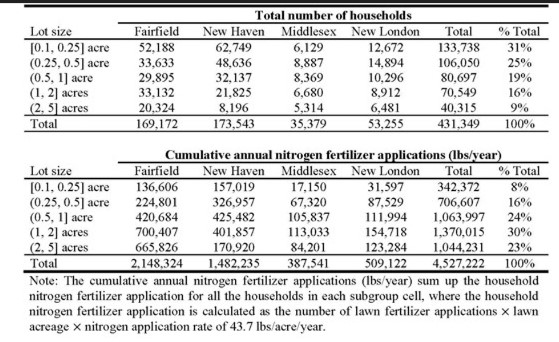
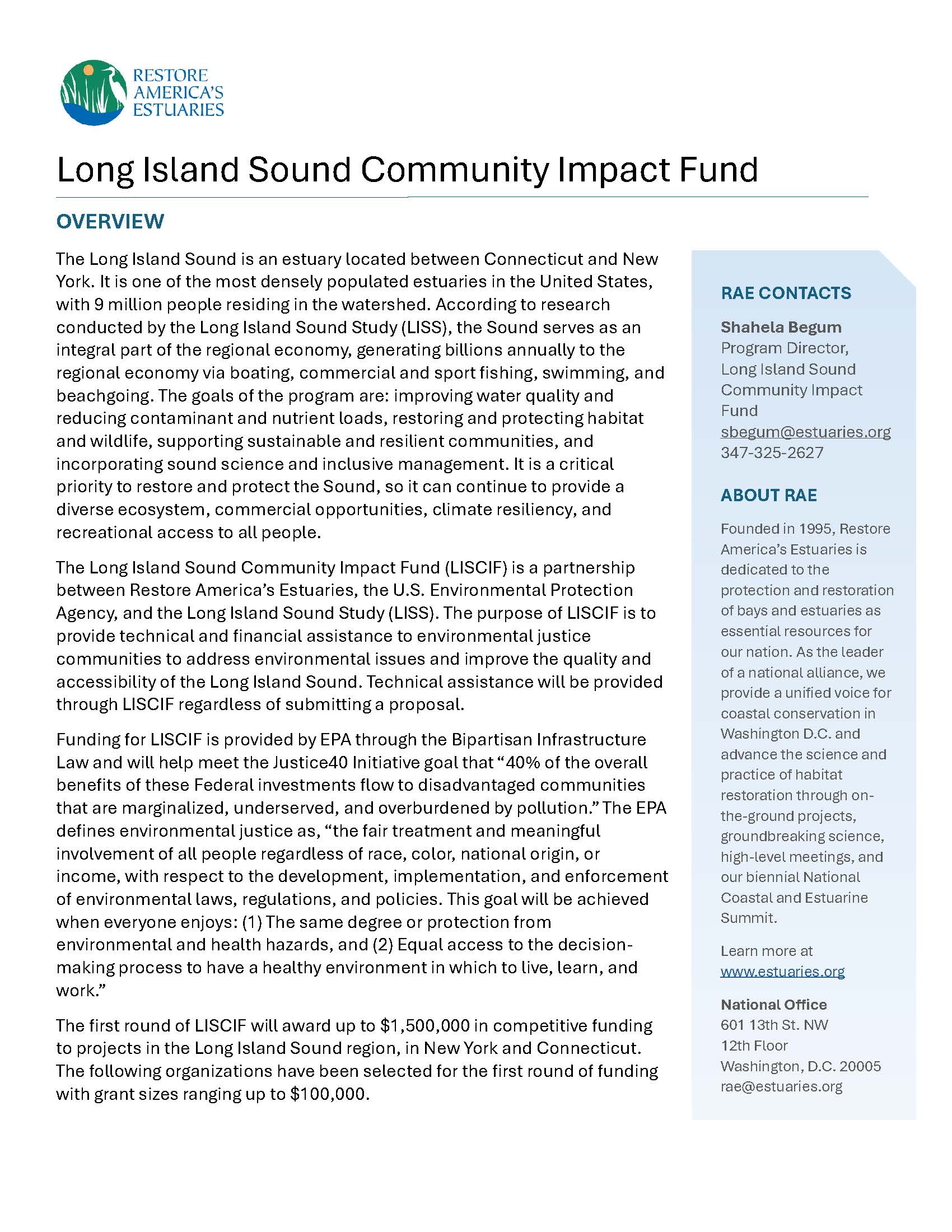
Descriptions of all of the projects funded in New York and Connecticut through the Long Island Sound Community Impact Fund is available as a fact sheet.
Program Aims to Build Capacity for Organizations and Fund Projects that Address Environmental Justice Issues Throughout the Long Island Sound
Contact: Brad Williams, Bwilliamson@esuaries.org
WASHINGTON, D.C. (May 8, 2024) – Restore America’s Estuaries (RAE) is pleased to announce subawardees for the Long Island Sound Community Impact Fund (LISCIF), which is a partnership with the U.S. Environmental Protection Agency (EPA) with funding made possible by the Bipartisan Infrastructure Law. A full list of subawardees is located on the LISCIF home page on the RAE website and the Long Island Sound Study LISCIF web page.
Each subawardee project was selected based on their ability to address challenges facing overburdened and underserved communities within the Long Island Sound estuary, managed under the Long Island Sound Comprehensive Conservation and Management Plan (CCMP). To support inclusion in the grant process, LISCIF provided capacity-building trainings and opportunities to applicants who historically have never received federal funds or needed additional support in navigating and managing a federal grant. By collaborating with community organizations throughout the process, funds are utilized to support projects in environmental justice areas while guiding applicants towards success within the grant cycle and long-term success in their mission.
The grant application was designed in two stages: 1) a Letter of Intent phase, 2) selected applicants were then invited to submit a Full Proposal. Applicants attended trainings on: Project Design & Building Partnerships, Grant Writing, Creating a Federal Budget, and Writing a Full Proposal to help support them in the application process. In addition, one-to-one calls were made available to provide further assistance as needed. In the first round of funding, 35 letters of intent were received from New York and Connecticut, requesting $2,583,323. Following recommendations from the review committee, 24 applicants submitted Full Proposals, requesting a total amount of $1,938,559.
LISCIF has $1.5 million to provide for the first round of funding, however, the total requested amount shows a greater need for funds and longer-term commitment to the Long Island Sound region. Restore America’s Estuaries has selected 18 subawardees for this round of funding, 11 organizations are from New York and 7 organizations are located in Connecticut. Grant sizes are up to $100,000.00 and subawardees have a year from July 2024 to complete their projects.
“RAE is proud to join with EPA and the Long Island Sound Study to support vital projects in the Long Island Sound region that will result in healthier communities and stronger community institutions,” said Daniel Hayden, President and CEO of Restore America’s Estuaries.
“The Biden-Harris Administration is happy to announce more than $900,000 in grants to New York awardees, secured through the Bipartisan Infrastructure Law funding. The funding will advance environmental justice for underserved communities along this estuary by helping them prevent pollution, build resilience and cultivate sustainability,” said Regional Administrator Lisa F. Garcia of EPA Region 2.
“The Long Island Community Impact Fund is a great example of how private organizations can come together with the federal government to affect change,” said EPA New England Regional Administrator David W. Cash. “The Bipartisan Infrastructure Law funding for this project will uplift underserved communities by giving them a seat at the decision-making table, resulting in a healthier, more resilient environment and community for years to come.”
“Preserving and protecting Long Island Sound is an environmental imperative. Thanks to the Long Island Sound Community Impact Fund, seven Connecticut organizations will receive federal funding to help with ecological health, shellfish restoration and other projects to protect this environmental treasure for future generations,” said Senator Richard Blumenthal.
“The more effort we put into protecting the Long Island Sound, the more it will give back to us, economically and recreationally. These awards from the Long Island Sound Community Impact Fund will inject more than half a million dollars into educational workshops and skills training, youth leadership development, and other local sustainability projects that will go a long way in keeping the Sound clean and healthy for future generations to enjoy. This is a great way to inspire a lifetime of environmental stewardship in people of all ages, and I look forward to seeing how the awardees bring their proposals to life,” said Senator Chris Murphy.
“The Long Island Sound (LIS) is one of our most treasured natural resources, and it is vital that we continue to support programs and services that maintain its health and vitality,” said Representative Rosa DeLauro. “As a former co-chair of the Long Island Sound Caucus, I am committed to securing funding for a revitalized Long Island Sound and secured $40 million for LIS in the 2024 funding bill. Having grown up on its shores, the Sound has always held a special place with me, and I am so proud to have the opportunity to work to ensure that its beaches and waters remain places for children and families to enjoy. I look forward to working with my congressional colleagues, RAE, and EPA to support vital projects in the Long Island Sound region.”
“The Long Island Sound and its watershed that spans six states is one of the most vibrant ecosystems in the world, helping to sustain the Northeast’s economy,” said Representative John B. Larson. “We secured record investments in the Bipartisan Infrastructure Law to revitalize the Sound by improving climate resiliency, combating pollution, and protecting habitats in Connecticut and across the Northeast. I will continue to work with the Connecticut delegation and my Long Island Sound Caucus colleagues to preserve our region’s unique ecosystem and support initiatives that advance environmental justice.”
“Thanks to the federal infrastructure law, organizations in Connecticut and across the region are receiving major investments to ensure the Long Island Sound remains a valuable resource for generations to come. This funding will go a long way in our work to preserve and protect the Sound and support communities along the estuary,” said Representative Joe Courtney.
“Here in Southwest Connecticut, we know well that keeping the Long Island Sound clean is paramount to the health of our planet, people, and coastal economy. I’m thrilled that the Long Island Sound Community Impact Fund (LISCIF), made possible by federal funding from the Bipartisan Infrastructure Law, will provide $1.5 million to protect people living on the frontlines of the climate crisis. From purifying our water to building resilient infrastructure, LISCIF-funded projects will help defend our invaluable natural resources and equip communities with the tools to tackle climate challenges head-on,” said Representative Jim Himes.
“Investing in maintaining the health of our watersheds is vital as we work to ensure communities across Connecticut have access to clean water sources and our wildlife can thrive. Projects like this are another way the Bipartisan Infrastructure Law is building a sustainable future for generations to come,” said Representative Jahana Hayes. “I am thrilled the Housatonic Valley Association will receive federal funding to continue educating students on the importance of protecting the Housatonic River and surrounding area.”
Prior to starting projects in July, RAE is excited to organize the Annual Learning Exchange on June 27th at the CUNY Graduate Center. This will be the first of several opportunities where subawardees, Tribal Nations, organizations, municipalities, and institutions will come together to workshop, collaborate, network, and learn from one another. Workshop themes are based on projects that will be funded for this round of funding.
RAE is excited to work with subawardees in the Long Island Sound Region to improve environmental justice issues while assisting organizations in their programmatic, non-profit/grants management needs.
For more information on LISCIF or the Annual Learning Exchange, please visit www.estuaries.org/liscif or direct questions by email to sbegum@estuaries.org.
About RAE: Restore America’s Estuaries is a national alliance of 10 of the leading coastal conservation groups in the United States dedicated to the protection and restoration of bays and estuaries as essential resources.
This news release originally appeared on the Restore America Estuaries website on May 8, 2024.
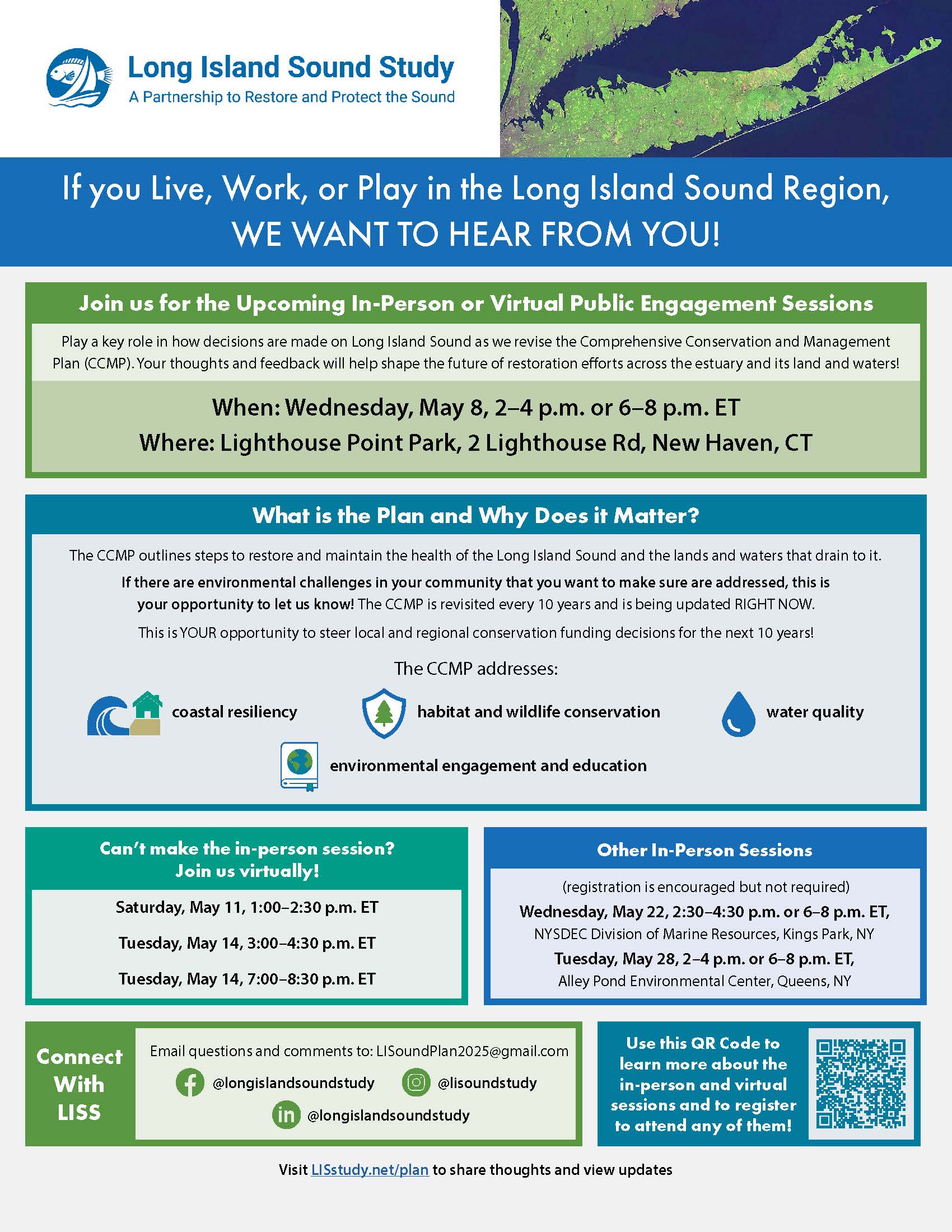
Flyers for CCMP Public Engagement Sessions in May 2024:
- May 8 (New Haven, CT): English, Spanish, and Chinese
- May 22 (Kings Park, NY): English, Spanish, and Chinese
- May 28 (Queens): English, Spanish, and Chinese
Long Island Sound Study to Sponsor 9 Public Engagement Sessions in May
The Long Island Sound Study is inviting residents of communities near Long Island Sound and throughout the watershed to attend an in-person or virtual public engagement session in May to learn about the challenges facing the Sound and the progress being made in its restoration. Attendees will be able to provide comments on what issues are important to them, which will be used to revise the Comprehensive Conservation and Management Plan, or CCMP, in 2025.
Six in-person sessions, scheduled for daytime and evening, are scheduled for sites in Suffolk County, Queens, and New Haven along with three virtual sessions.
The CCMP addresses current and emerging issues for Long Island Sound: clean water, thriving habitats and abundant living resources, sustainable and resilient communities, and public involvement and stewardship. The Long Island Sound Study, a partnership of federal and state agencies working with local governments, communities, universities, and industry uses the CCMP as a blueprint to develop specific, measurable objectives to improve the health of the Sound and to commit to action plans to achieve them. It was last revised in 2015. You can find out more about the update plans here: A New Plan for 2025-2035.
The meetings will include:
- A presentation on Long Island Sound, progress and challenges, and opportunities to help set future goals and action plans
- Tabling/Breakout sessions to brainstorm and gather feedback from participants on issues and objectives, hear what’s important to attendees
- Plenary discussion of comments/feedback
- Ideas for renaming the program
- Review of next steps
This is a broad stakeholder meeting – all interested in Long Island Sound are invited!
In-person Sessions
- Wednesday, May 8, 2–4 p.m. and 6–8 p.m., Lighthouse Point Park, 2 Lighthouse Rd, New Haven, CT (Carousel Building; attendees are encouraged to park in the upper lots and walk to the building)
- Wednesday, May 22, 2:30–4:30 p.m. and 6–8 p.m., NYSDEC Division of Marine Resources, Kings Park, NY
- Tuesday, May 28, 2–4 p.m. and 6–8 p.m., Alley Pond Environmental Center, Queens, NY
Registration for all in-person events is being coordinated by the Eastern Research Group on contract to EPA. Go to the following link to register for the session you want to attend.
Remote Sessions
- Saturday, May 11, 1:00–2:30 p.m. Register.
- Tuesday, May 14, 3:00–4:30 p.m. and 7:00–8:30 p.m. Registration for the daytime session and evening session.
Contact LISoundPlan2025@gmail.com for additional information.
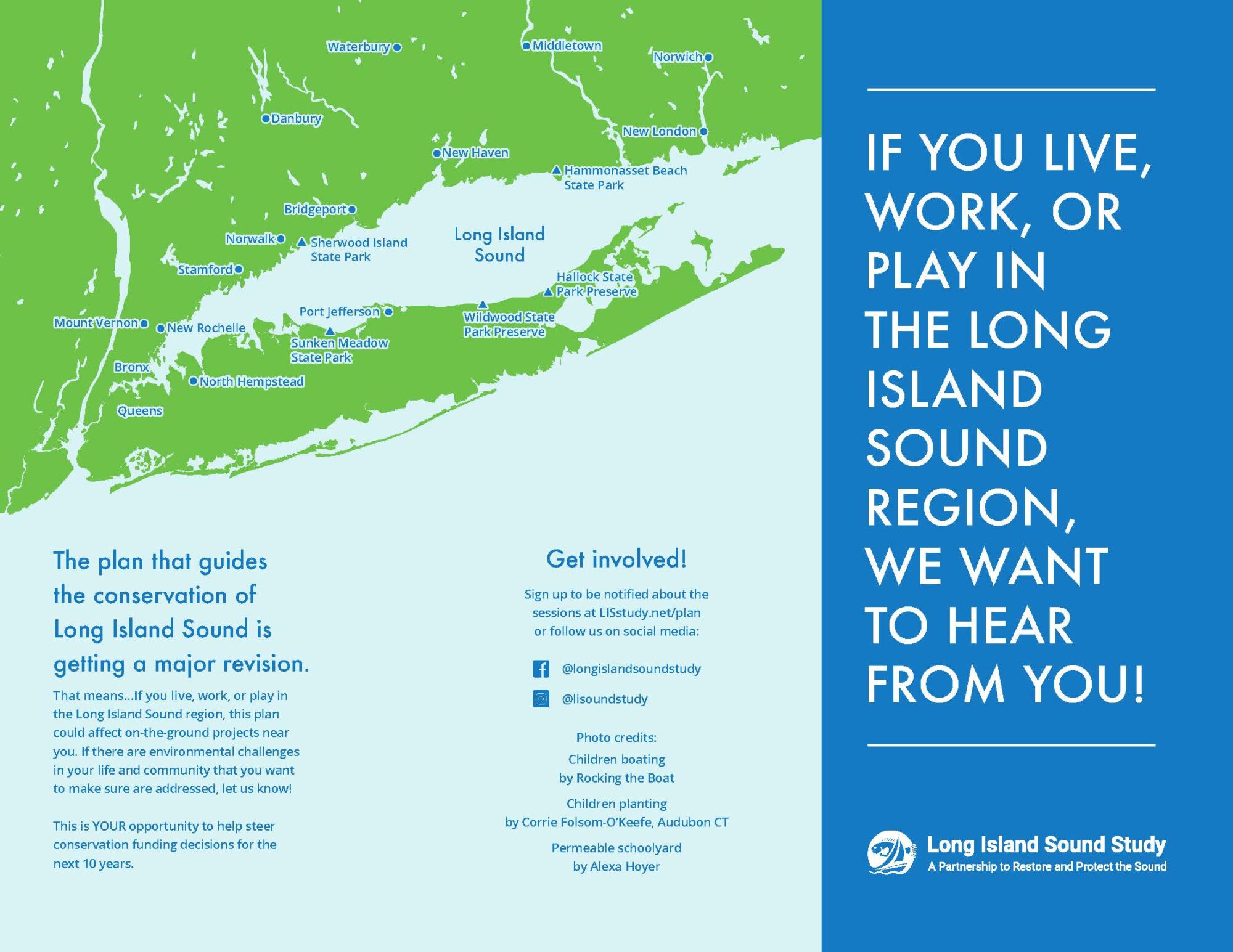
The Long Island Sound Study is revising its Comprehensive Conservation and Management Plan, the plan that guides the conservation of Long Island Sound. LISS is distributing a brochure to inform residents that they have an opportunity to participate in the planning process.
Contact Jimena Perez-Viscasillas at jbp255@cornell.edu if you are interested in receiving print copies of the brochure.
Spanish language version of brochure
Chinese language version of brochure
For Immediate Release: February 28, 2024
Contacts:
Judy Benson, CT Sea Grant communications coordinator: judy.benson@uconn.edu.
Paul C. Focazio, NY Sea Grant communications manager: paul.focazio@stonybrook.edu
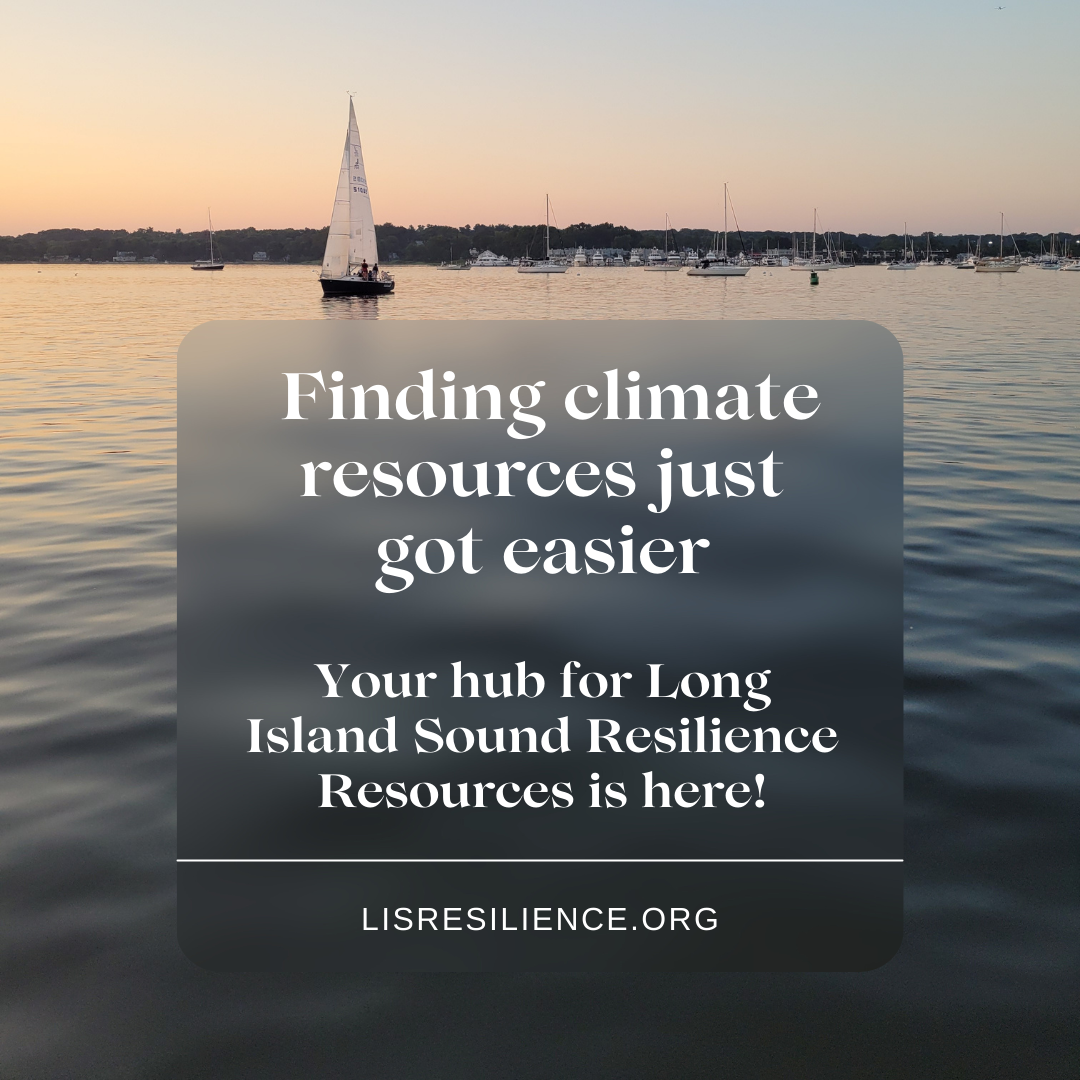
The Long Island Sound Study announces the official launch of the Long Island Sound (LIS) Resilience Resource Hub website, a user-friendly platform designed to enhance the resilience of New York and Connecticut coastal communities.
About the LIS Resilience Resource Hub
The LIS Resilience Resource Hub is a comprehensive online resource, offering tools, information, guidance, and inspiration to support the sustainability and resilience of Long Island Sound communities. Developed in response to stakeholder needs, this hub is a one-stop-shop for resources related to climate resilience planning and project implementation.
Website URL: lisresilience.org
Key Features
- Curated resources organized by location, topic, and project planning phase.
- Funding Database: access an up-to-date database of resilience-related funding opportunities to support projects and initiatives.
- Resilience Planning Guide: navigate through eight key criteria to guide sustainable and resilient project development.
- Trainings and Events: stay informed about upcoming workshops and trainings focused on building community resilience, and access recordings and materials from past events.
- Case Studies: explore an interactive map that showcases recent resilience initiatives.
Background
The Long Island Sound Study (LISS) is a collaborative bi-state partnership established by the EPA, New York, and Connecticut, which brings together federal and state agencies, user groups, concerned organizations, and individuals dedicated to restoring and protecting Long Island Sound. LISS’s Sustainable and Resilient Communities Work Group is supported by a team of five Extension Professionals working through Connecticut Sea Grant and New York Sea Grant, who are strategically located in Nassau, Suffolk, and Westchester Counties in New York, and in eastern and western Connecticut.
By providing training and tools–such as the LIS Resilience Resource Hub–that foster a coordinated regional response to the impacts of climate change, the Extension Professionals are helping empower Long Island Sound decision makers with enhanced knowledge and skills, ultimately boosting the implementation of sustainable and resilient projects throughout the region.
“On behalf of our team here with Suffolk County Department of Economic Development and Planning, we feel very fortunate to be given the opportunity to test the new website prior to public launch. It’s a beautifully designed portal and a great tool that we plan to share broadly with our departmental colleagues to meet shared project goals and regional resiliency planning objectives. We will continue to stay tuned as to LISS updates and future trainings/events to remain involved. Thank you, SRC team, for all of the hard work to advance this regional effort.“
Kendra Armstead, Senior Community Development & Planning Specialist
Department of Economic Development and Planning
Suffolk County
About CTSG/NYSG/LISS
For more on Connecticut Sea Grant, visit https://seagrant.uconn.edu or follow CT Sea Grant on Facebook (https://www.facebook.com/ctseagrant) and Instagram (https://www.instagram.com/ctseagrant).
For more on New York Sea Grant (NYSG), a 50+ year cooperative program of Cornell University and the State University of New York (SUNY), visit www.nyseagrant.org or follow NY Sea Grant on Facebook (https://www.facebook.com/nyseagrant), Twitter (https://www.twitter.com/nyseagrant), Instagram (https://www.instagram.com/newyorkseagrant), and/or YouTube (https://www.youtube.com/nyseagrant).
For more on the Long Island Sound Study, visit www.longislandsoundstudy.net or follow LISS on Facebook (www.facebook.com/longislandsoundstudy), Instagram (www.instagram.com/lisoundstudy), and LinkedIn (www.linkedin.com/company/long-island-sound-study).